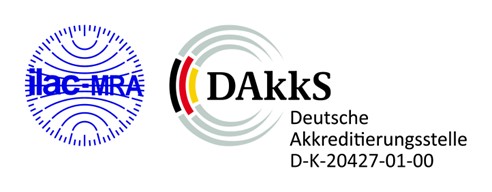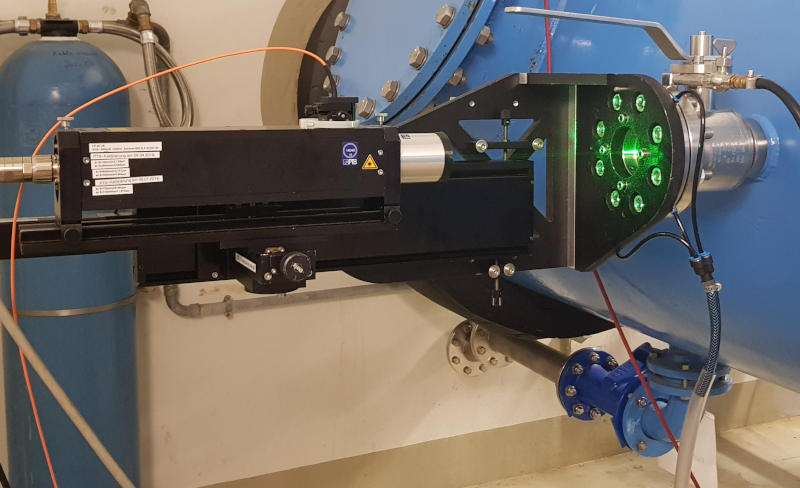On-site calibration of large flow meters (OSC)
As a service, we offer laser-optical on-site calibration (OSC) of large flow or volumetric flow meters (for water):
- The calibrations are carried out under operating conditions (i.e. without dismounting the flow sensors).
- So far, over 200 measuring devices for heat, cooling and drinking water have been calibrated under operating conditions.
- We have been a DIN EN ISO/IEC 17025:2018 accredited calibration laboratory since 2017.
Structure
- Motivation / Advantages
- Calibration offer and examples
- Technology
Motivation
Large heat and water meters are often used continuously for decades after initial calibration on the test bench. Up to now, recalibration has not been possible in the installed condition. At best, the flow meters are removed and recalibrated on a test bench. This involves an interruption of the supply and high costs.
Possible reasons for measurement deviations during operation are:
- different fluid and flow conditions during initial calibration and in use
- system-related compromises in the installation of the measuring instruments
- drift of the measuring instruments over the often very long period of use and
environmental influences.
More precise measurement results are important for:
- the determination of key figures (e.g. for CO2 emissions trading)
- improved measurement accuracy in billing
- the discovery of savings potentials through more precise balances
- the determination of causes for water/heat losses and
investment decisions.
Your advantages through on-site calibration:
- On-site calibration under operating conditions (!)
- No interruption of supply during preparation and execution of measurements
- Highest quality and international recognition through accreditation according to DIN EN ISO 17025:2018
- Manufacturer-neutral, independent calibration for all air terminal units
- Recognition by DEHSt for national emission monitoring (in Germany)

Example for temporal variation of the measurement deviation of a flow sensor

Example calculation for savings potential (district heating)
Calibration offer
We are accredited for on-site calibration (OSC) according to DIN ISO IEC/ISO 17025: 2018 under the following conditions:
|
Medium |
Water |
|
Fluid temperature |
5 °C to 150°C |
|
Volumetric flow rate |
unlimited |
|
Volumetric |
> 0,3 m/s (recommendation) |
|
Pipe diameter |
from DN 100 to approx. DN 1200 |
|
Max. fluid pressure |
25 bar (40 bar without hot tapping) |
|
Pipe material |
stell, cast iron (also with internal coating) |
Our accreditation has an international validity within the framework of ILAC.


Application of OSC in district heating supply

Application of OSC in cooling supply

Application of OSC in potable water supply
Technology
The measurement technology is based on the well-known method of laser Doppler anemometry/ velocimetry (LDA/LDV). The local flow velocities are measured on one (or if necessary several) measuring paths along the pipe diameter (velocity profiles).
The optical access to the fluid required for this is realised under operating conditions (i.e. without supply interruption) using the hot tapping method. The internal pipe geometry can be determined indirectly by measuring the outer diameter and wall thickness or directly by optical means using a specially developed triangulation method (OPTOpipe).
The relative trend of the volume flow fluctuating during the measurement time is taken into account by normalising (cf. ISO 3966) the LDV measured values with the measured values of two additionally installed ultrasonic clamp-on measurements. The measured values of the flow sensor (FS) to be calibrated are recorded with high temporal resolution during the LDV measurements. The measurement deviation of the FS is determined by comparing the volume flow determined with the LDV method and the time-averaged value of the FS during the measurement time.
The measurement uncertainty of the method depends strongly on the flow conditions encountered on site. Therefore, the measurement location for the in-situ calibration must be chosen with appropriate care. The flow conditions are divided into different profile classes by means of a key figure system. Table 1 shows the typical measurement uncertainties for the individual profile classes. The values correspond to realistic measurement uncertainties (from the measured value) and are multiplied by a coverage factor of k = 2 (confidence interval 95 %).

Typical OSC measurement uncertainties (k=2) for the volume flow dependig on the profile classes

Principle of optical flow measurement using LDV

Bored out pipe disc with cement lining (drinking water pipeline)

Typical OSC measurement in a district heating pipe

Result diagram of an on-site calibration
Contact
Dr. Ulrich Müller
E-Mail: mueller@optolution.com
Telefon: +49 7621 160 15 15
Downloads
- Flyer "Introduction on site Calibration (OSC)"
- Flyer "Preparation and Measurements of OSC"
- Accreditation certificate of the laboratory
- Annex to accreditation certificate
- Application sheet district heating
- Application sheet potable water
- Publication "Improving operational efficiency of power plants through on-site calibration of flow sensors"